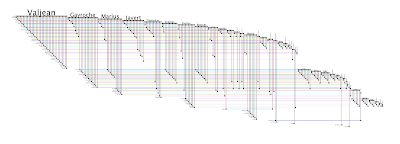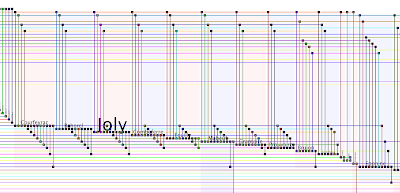In a recent post, I used Mother Innocent as an example to demonstrate how shadow links are a way to show a complete inventory of links incident on a node, and also to insure that each node has a presence on the main diagonal of a BioFabric graph:
Though a node named Mother Innocent may seem a little strange, it all makes sense when you know that she is a character in Victor Hugo's famed novel Les Miserables, and the network is Knuth's well-known graph of character occurrences in that novel [D. E. Knuth, The Stanford GraphBase: A Platform
for Combinatorial Computing, Addison-Wesley, Reading, MA (1993)].
If you go back and read that post, I talked about the links between Valjean, Faucheleven, and Mother Innocent. But when I speculated on the latter's popularity and residence, I was coming from a position of (almost) complete ignorance about the actual domain that is modeled by the network. Since I had a conference trip coming up (go take a look at my posters!), I figured that the 1194-page novel (Julie Rose translation) was a great way to pass the travel time. Plus, it allows me to conduct a little experiment. When I first played with the graph data and ran it through the various BioFabric layout alternatives, I was completely in the dark, but I could start to get a feel for the data and how the characters might interact. Now, by the time I get to the end of Hugo's novel, I will be enough of a domain expert to be able to look at the data with a different set of eyes.
As of this moment, I am only on page 480. And Hugo famously went off on tangents in this novel: Adam Gopnik, in the book introduction, refers to them as "the gassy bits", the parts that are in contrast to the dramatic sections of the novel. In fact, I've just waded through 36 pages discussing the details of convent life and how monasticism was an anachronism in the modern world of the mid-19th century. But even with that, it's been a great read.
But I have covered enough ground to be able to say with authority that [SPOILERS AHEAD] Mother Innocent indeed had a home. She lived in the Convent of the Bernadines of Perpetual Admiration, at No. 62 petite rue Picpus, Paris. Few of the nuns interacted with the outside world, but Mother Innocent (aka Mademoiselle de Bleumeur) was the prioress, and therefore was the one who could talk with Faucheleven (the convent's gardener) and the soon-to-be assistant gardener Valjean. This discussion took place because Jean Valjean was not buried alive in the supposedly empty coffin in Vaugirard Cemetery. And I might argue that there should be a link between Gribier and Valjean in the network, since the former was quite stubbornly (albeit unknowingly) trying to accomplish the live-burial of the latter.
So, although I've recently been spotty with BioFabric postings due to travel, I've been putting my spare time to good use: reading an 1862 French novel to further the cause of network visualization.
Interesting side note: I seem to have cornered the market on image searches for "Mother Innocent" (in quotes). Go take a look: Google Image Search










